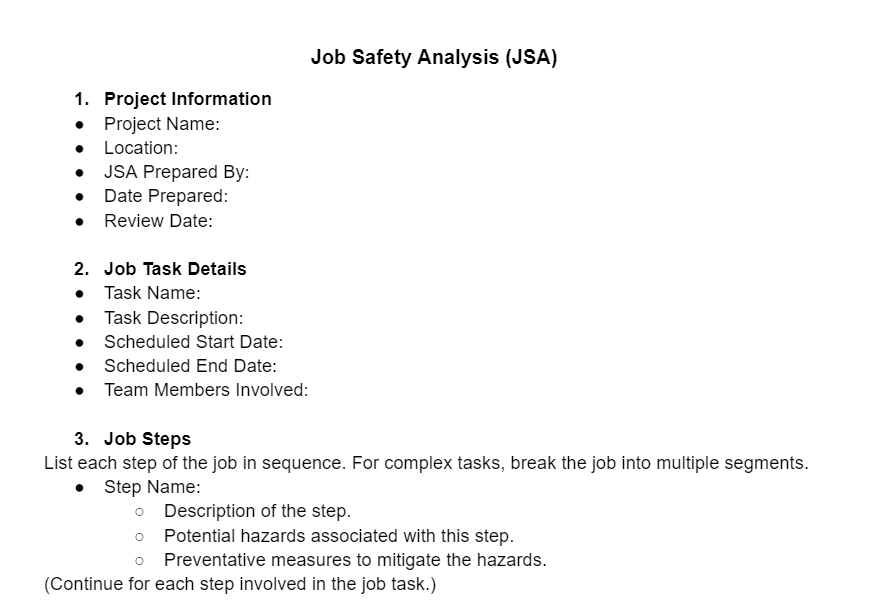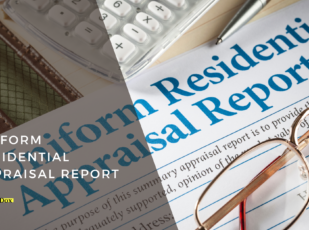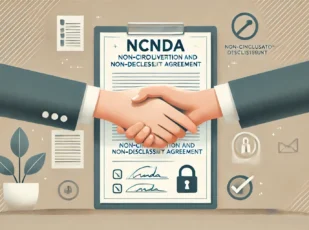
Job Safety Analysis Template
9 Downloads
Commercial
January 11, 2025
Sayantani Dutta
Today, ensuring the safety and well-being of your employees is not only your moral obligation but also a legal requirement. A Job Safety Analysis (JSA) document is the tool organizations use for this purpose. The idea is to identify potential job hazards and implement effective control measures before any damage is done, thus protecting your organization’s employees on the principle of “Prevention is better than cure.” Except, in this case, it could be “Prevention is better, much better, than expensive lawsuits.”
In today’s guide, we are going to take a closer look at the essence of a JSA, covering what it is, how it works, what benefits it offers to your organization, and why you should never rely on a generic, free template to draft such a crucial, legal piece of documentation that your company relies on. This is no place to cheap out! We will also introduce you to the ideal solution—our very own Job Safety Analysis Template that you can customize as per your needs. It is professionally drafted by experts and 100% legally sound.
Without further ado, let’s dive right into it!
What is a Job Safety Analysis?
Job Safety Analysis or Job Hazard Analysis (JHA) is a systematic process that aims to help prevent workplace accidents and injuries by identifying potential hazards associated with specific job tasks. Specifically, the process entails breaking down a job into its individual tasks, analyzing each step for any risks associated with it, and then determining the best ways to mitigate these risks, dangers, or hazards that can harm employees and workers.
When used correctly and proactively, a proper JSA procedure is an important element in creating a safer work environment for everyone. It also ensures compliance with safety regulations.
It is all about doing a proper analysis and risk assessment, then tackling the identified hazards in the job steps. For example, if a step has physical risk that can be mitigated by using personal protective equipment (PPE), the JSA process will recommend this to all workers. The same applies to lab safety preventive measures, for example. In these situations, the real value is in the fact that you are protecting your workers or employees from future injuries.
Alternatively, a bad way to go about it is to witness injury first (or a near miss that could have led to serious injury) and then enact a safety program focused specifically on that step of the job. This is not sufficient for hazard control and is a bad example of workplace safety.
In more high-risk situations, occupational safety training and safeguards against things like lockouts need to be enforced as quickly as possible—not just to keep your workers and employees safe, but to operate legally.
Importance of JSA
The importance and significance of job safety analysis cannot be overstated—especially in work areas that have a higher risk or a history of workplace injuries. You might think that accidents can be tackled head-on and that you have already protected your workplace against everything, but it is very likely that something has skipped your notice.
A detailed, step-by-step approach to break down job activities into steps and then to analyze those steps has become the industry standard all over the world. Surely, there must be a good reason. Examples of how organizations and factories were able to identify workplace hazards that often skipped notice are all too common.
Be proactive, prevent injuries, and secure your work practices. It is extremely important.
When you identify potential hazards with JSA, you can implement the necessary preventive measures, which significantly reduce the likelihood of workplace accidents. This drop in (would-be) accidents is hugely beneficial to your organization—so much so that the initial time and money that goes into the analysis is comparatively negligible.
Also, let’s not forget that you have to ensure compliance with safety regulations. A lot of industries are regulated by stringent safety laws. A JSA will ensure that your organization’s work practices are consistently meeting, if not exceeding, these regulatory requirements. This helps you avoid legal repercussions, potential fines, damage to reputation, sure. But to be frank, it also helps you be a good example of a company. That is always something to strive toward.
Notably, the process of conducting a JSA has a surprising side-benefit—it actually educates employees or workers about the risks associated with their tasks and the importance of following safety protocols. Whatever small likelihood that could not be completely taken out of the equation gets the final push with this increased awareness. Everybody wins and your workers learn those safety measures for their life.
It is the perfect win-win situation.
Risks of Inadequate JSA
Neglecting the importance of a comprehensive JSA or resorting to inadequate, free templates available online to draft your analysis reports can have truly dire consequences. For the most part, these generic templates are simply not comprehensive enough. As a result, you are looking at an increased risk of accidents.
Needless to say, without a detailed analysis of job tasks, your employees remain unaware of potential hazards and safety protocols. This leads to a significantly higher risk of accidents and injuries in your workplace.
Also, these templates are highly likely to not cover all legal and regulatory bases. As a result, there will often be legal and financial repercussions. It is no secret that organizations are often at the receiving end of legal action, hefty fines, and compensation claims. This can significantly affect your company’s financial health and, more importantly, cause undoable damage to your company’s reputation.
Ultimately, all this leads to a drop in productivity. Workplace accidents are well-known to cause absenteeism, reduced morale, and decreased efficiency on a daily basis.
Key Elements in a Job Safety Analysis
A proper Job Safety Analysis document will have a few key components. In total, there are four items to consider:
- Task Identification: A clear description of each job task, broken down step by step.
- Hazard Identification: An analysis of potential hazards associated with each task.
- Risk Mitigation Measures: Specific actions or controls to eliminate or reduce the risks.
- Responsibility Assignment: Designation of individuals or teams responsible for implementing safety measures.
Protect Your Work Procedures with FreshDox.com
Now, any organization can protect their workplace with a robust, legally sound template that offers regulatory compliance! Depending on your needs, you can also customize the template and download it in Word (.docx) or PDF format.
FreshDox.com’s comprehensive Job Safety Analysis Template is meticulously designed to meet the highest standards of workplace safety and compliance. Unlike basic, generic, and often inadequate free templates that you are bound to run into from time to time, our JSA Template is developed by workplace safety experts and legal professionals—ensuring that it covers all necessary aspects of job safety analysis.
The best part? Depending on the nature of your business or work, you can customize it to fit your unique needs! And we have so much more to offer with our vast collection of business and legal document templates that anyone can download. We have provision for a 14-day trial, using which, you can test our Basic and Premium Plans. The Basic Plan allows you to download up to three document templates a month whereas the Premium Plan is ideal for those who need unlimited templates.
Whether you are a safety consultant, HR professional, or a business owner—FreshDox.com gives you the right tools to protect your organization from workplace injuries and safety hazards.
So, what are you waiting for?! Sign up for a FreshDox.com account today and say yes to better, time-saving safety compliance and peace of mind by securing your workplace with legally sound and professionally developed documents. Avoid the pitfalls of inadequate job safety analysis starting today by making an account on FreshDox.com and using our expertly developed JSA Template!
Related Templates
Discover more templates that align with your needs and preferences.

Ready to Sign Up?
Sign up for FreshDox.com’s 7-day trial and discover why so many individuals and businesses trust us for their legal document template needs.
- Cancel any time
- 7-day free trial
- From 300+ Customer Reviews
















